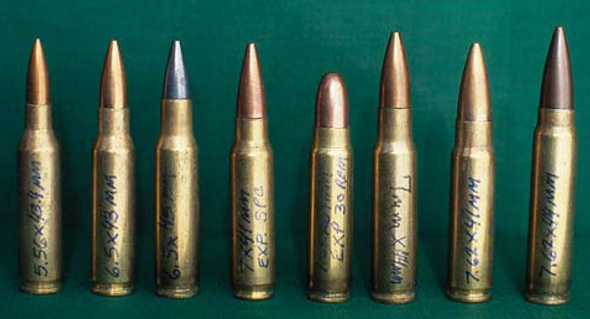
The question of what a cartridge’s name means is not as clear today as it was back in the good ‘ol days. Photo courtesy Cartridges of the World, 11th Edition.
Wild Bill Shakespeare tells us that a rose by any other name would smell as sweet. Meaning, I guess, that the names of things aren’t as important as their essence.
Ha! Try telling that to cartridge manufacturers. Quantum physics is a game of Candyland compared to figuring out our American “system” of cartridge names. It wasn’t always so bad. Before the era of self-contained metallic cartridges, life was sunny and shooters hadn’t a care in the world.
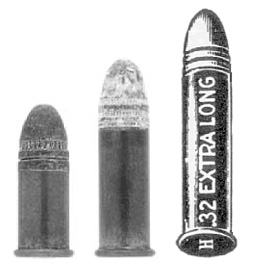
From left to right, the .32 Short, .32 Long and .32 Extra Long. The .32 Extra Short (not shown), for example, was a .32-caliber cartridge that was, well, pretty damn short. The .32 Extra Long (right) was pretty damn long. The .32 Long (middle) was just kinda average. From Cartridges of the World, 13th Edition.
After all, if you knew the approximate caliber of your rifle, all you had to do was to dump a palmful of blackpowder down the bore, stuff in a spit-patched ball or conical bullet, cap ‘er up, and let fly. Life was simpler then. The sky was crusted o’er with bluebirds. Dan’l Boone wore a big toothy smile, and injuns grinned and waved as he shot them.
Things were almost as straightforward when the combustible paper cartridge briefly superseded loose powder and shot during the Civil War. Used in guns such as the Sharps carbines and infantry rifles, the combustible cartridge was nothing more than a powder-stuffed paper tube tied to a bullet.
These paper rounds looked like scaled-down Dutch Masters panatelas and smelled almost as good when they burned. You distinguished one from another pretty much by pointing your finger and saying “this one” or “that one.” But they worked just fine, though they sometimes got wet, fell apart, or obstinately failed to combust.
But the paper cartridge was obsolete before it even got started. Years earlier, in the 1840’s, some anonymous European tinkerer had stuffed a .22 round ball into a percussion cap, and voila! the metallic cartridge was born. It was a monumental technological step forward, but before long the waters had become hopelessly muddy, especially in regard to distinguishing one cartridge from another. The only way to do that was with a name, and therein lay the rub.
Many of the earliest metallic rimfire cartridges, all of them by necessity blackpowder, bore honorific names indicating the inventor of the rifle for which they were chambered. These names were always informative but rarely memorable, to wit: .44 Henry Flat, .56 Spencer, .58 Miller. If you carried a Miller rifle, you needed a Miller cartridge, and that was that. You were safe as long as you could read a cartridge box.
Other early rimfires bore bland dimensional names that gave you a rough idea of their relative length and hence power: .32 Extra Short, .32 Short, .32 Long, .32 Long Rifle, .32 Extra Long. Some of these latter cartridges might have reached a length of several feet had the supply of adjectives held out. What these early names lacked in romance they made up for in meaning.
The .32 Extra Short, for example, was a .32-caliber cartridge that was, well, pretty damn short. The .32 Extra Long was pretty damn long. The .32 Long was just kinda average.
But such simple nomenclatural logic started falling apart in the mid-1860’s when bottlenecked cartridges were invented. Because many of the early lever-action repeaters were restricted to fairly short cartridges, the only ways to cram more powder behind a bullet were to blow out the case shoulder or squeeze down the case neck, both of which also improved headspacing and feeding.
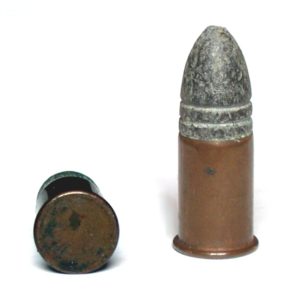
The 56-56 Spencer. The first number referred to the caliber of the original straight case; the second to that of the necked-down derivative case. Or something like that. Photo by Hmaag.
Thus when Christopher M. Spencer necked down his original straight-cased .56 Spencer rimfire to .46, he thought it proper to call the new smallbore round the .56-.46 Spencer, combining both its names in the hyphenated style so common nowadays in chic yuppy marriages. The first number referred to the caliber of the original straight case; the second to that of the necked-down derivative case.
So far, so good. But Spencer soon realized that folks might confuse the .56-46 with his original .56, so he took to calling the earlier round the .56-.56 Spencer. This retroactive christening may have enlightened some shooters, but it left others looking in vain for a bottleneck that wasn’t there. To alleviate some of the mess he had created, Spencer helpfully referred to the .56-.46 cartridge as both the “#46” and the “46/100” in his catalogues. Good old #46.
Realizing that his supply of numerals was virtually inexhaustible, Kit Spencer fell victim to a mad frenzy of bottlenecking. Before the end of the decade, you could buy a Spencer rifle (the gun you “loaded on Sunday and shot all week”) in .56-.56 Spencer, .56-.52 Spencer, .56-.50 Spencer, or .56-.46 Spencer. And those were just the fifty-sixes! Within a few years, Spencer’s bottleneck fever had spread to a promising upstart, former shirt manufacturer Oliver Winchester, d/b/a Winchester Repeating Arms, Co.
Ever the innovator, Ollie Winchester modified B. Tyler Henry’s .44 Henry Flat rimfire into a centerfire in 1873, crimped on a tiny bottleneck, and gave the world the .44-40 Winchester (aka .44 WCF). He was just getting warmed up.
Flinging his cravat to the floor and hollering, “Don’t stop me, boys!” Winchester then bottlenecked the already-bottlenecked .44-40 even further, which resulted in the .38-40 Winchester (aka .38 WCF). Now shooters had to digest a new nomenclatural pattern quite unlike Spencer’s, one in which the first number (e.g., .44 or .38) referred to caliber and the second (e.g., 40) to the cartridge’s black powder charge expressed in grains.
Over the years, Winchester and his minions begat a brood of hyphenated cartridges (.40-65, .40-72, etc., etc., etc.) that still leaves us scratching our heads today. The last known outbreak of bottleneck fever ravaged New Haven, Connecticut, in 1882, leaving the .32-20 WCF and .25-20 WCF in its wake.
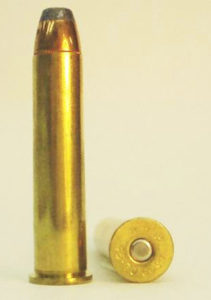
The .45-70-405 Government cartridge of 1873 combined a 405-gr. .45-caliber lead bullet with 70 grains of black powder.
Confusing as they sometimes were, at least the old blackpowder cartridge designations meant something. They had to. Back in those days, you couldn’t just saddle up Ol’ Bo and gallop over the ridge to the nearest Wal-Mart when your rifle ran dry.
You had to handload your ammunition, pilgrim, and you better know how to do it. Many of the old blackpowder cartridge designations were really just cheat-sheets that told you how to put together a given load. The .45-70-405 Government cartridge of 1873, for example, combined a 405-gr. .45-caliber lead bullet with 70 grains of black powder.
The .45-90-405 was a longer version of the Government with an extra 20 grains of blackpowder. The massive .50-140-3-1/4 Sharps of 1880 threw together a .50-caliber bullet, a whopping 140 grains of blackpowder, and a 3-1/4”-long brass case. I assume you hired someone to fire it for you.
Things got a little gray in 1895 when the first American smokeless cartridges, the .30-30 and .25-35 WCF, hit the stores. Judging by name alone, you might think that these were old-formula blackpowder cartridges like the .44-40 and .38-40, but not so. The “-30” and “-35” represented the grain weight of the cartridges’ smokeless powder charges.
Not that the industry actually encouraged anyone to go out and reload the new smokeless cartridges. William T. Lyman, in his Ideal Handbook, implied that the new-fangled powder was only a little less touchy than nitroglycerin. Everybody was ignorant about the new “whitepowder,” as it was called in those early days, and cartridge manufacturers had nightmares about Farmer Brown over in Zanesville topping off a .30-30 case with Dupont smokeless shotgun powder and blowing his durn fool head clean off.
Anyway, the smallbore, fast-twist .30-30 and .25-35 rifles became hopelessly clogged with fouling if blackpowder was used in them, so Winchester hit on a happy idea that no doubt tickled Bill Lyman: the .32 Winchester Special of 1895. The .32 WS was a smokeless cartridge meant to be reloaded with blackpowder. It’s still a good deer cartridge, especially (as Frank Barnes says) “for those who don’t believe that smokeless powder is here to stay.”
In those waning days of the 19th century, two commandments governed the firearms industry:
I)Thou shalt not underbid a government contract.
II)Thou shalt not put a competitor’s name on thine own product.
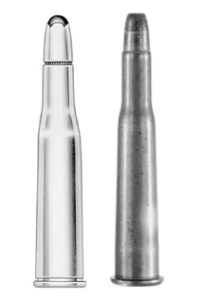
When the .25-35 Winchester of 1895 (left) appeared to be enjoying healthy sales, Marlin jumped into the fray with their own version, the .25-36 Marlin (right). (That “-36” was supposed to fool everybody.)
For this last reason, every successful new cartridge was viciously knocked-off by the competition, usually in slightly modified form to avoid charges of plagiarism.
For example, when the .25-35 Winchester of 1895 appeared to be enjoying healthy sales, Marlin jumped into the fray with their own version, the .25-36 Marlin. (That “-36” was supposed to fool everybody.) The Marlin round’s case dimensions differed enough from the Winchester’s that the two were not interchangeable, as some oafish shooters discovered when their rifles wouldn’t feed or eject properly.
Remington, which didn’t offer a lever-action design, had to sulk in its corner until 1906, when they introduced a rimless version of the .25-35 in their famous Model 8 autoloading rifle. The new Remington cartridge, called (surprise!) the .25-35 Remington—later the plain old .25 Remington–was one of three Remington rimless clones of well-established Winchester rimmed rounds, the other two being the .30-30 and .32 Remington. A fourth chambering, the .35 Remington, appears to have been original.
Sometimes fin-de-siecle smokeless cartridges were named to avoid confusion with existing blackpowder cartridges. We’ve seen that the .32 Winchester Special really was special, in a dumb kind of way, but ever wonder what’s so special about the .38 Special?
Today, it doesn’t seem very remarkable at all, but when it was introduced in 1898 it seemed, well, special when compared to the shorter, slower .38 S&W blackpowder round introduced in 1871. (To make matters worse, the .38 S&W itself later became known as both the .380 and the .38/200. Take your pick.)
Similarly, the .45 Colt cartridge of 1873 used to be called the .45 Long Colt, at least in non-military circles. The “Long” distinguished it from its “short” counterpart, the .45 Schofield, which was chambered in the huge S&W Army Model top-break revolver designed in part by Major George W. Schofield.
Later, the “Long” seemed a conversational necessity to avoid confusion with the shorter, smokeless .45 ACP, first chambered in a subdued form in the 1905 Colt Automatic Pistol, and the .45 Auto Rim, chambered in the no-nonsense 1917 Smith & Wesson and Colt army revolvers.

No comments:
Post a Comment